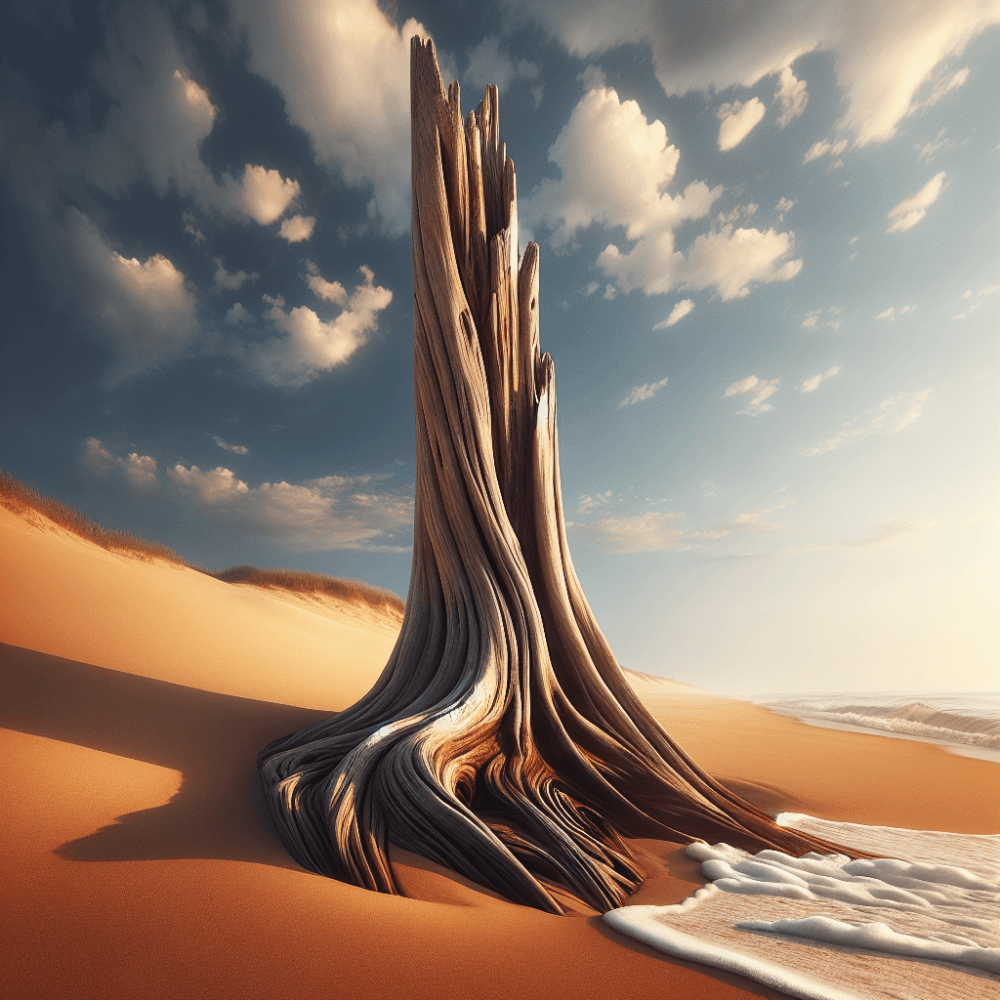If you’ve ever strolled along the shoreline and stumbled upon a piece of driftwood, you may have wondered, does driftwood make good firewood? After all, the weathered and worn appearance of these sea-washed logs is undeniably alluring. In this article, we will explore the qualities of driftwood as firewood, examining both its advantages and potential drawbacks. So, before you gather up those unique beach findings for your next campfire, read on to discover whether driftwood is truly a reliable option to keep you warm and toasty.

What is driftwood?
Driftwood refers to any type of wood that has been washed onto the shore or other bodies of water by wind, waves, or currents. It is commonly found on beaches, riverbanks, and lakeshores. Driftwood can come from various sources, including trees and branches that have fallen into water bodies or have been carried downstream by rivers.
Definition
Driftwood is essentially wood that has been detached from its original location and transported by water. It often undergoes a weathering process due to exposure to elements such as sun, water, and wind, which gives it a distinct appearance and characteristics.
Origin
Driftwood can come from a variety of sources, including broken tree limbs, fallen trees, and even man-made structures such as piers and docks. It can be found in both freshwater and saltwater environments, depending on the location.
Characteristics
Driftwood usually has a weathered appearance, with a smooth and worn texture. Its color may vary depending on the length of time it has spent in the water and the type of wood from which it originated. It is typically lightweight and porous, making it easy to handle and transport.
Properties of Driftwood
When considering driftwood as firewood, several properties should be taken into account to determine its suitability.
Density
Driftwood generally has a lower density compared to other types of firewood. This means it may burn faster and produce less heat compared to denser woods like hardwoods.
Moisture Content
Being exposed to water for a significant period, driftwood tends to have a higher moisture content. This can result in difficulty in igniting the wood and can also lead to increased smoke production when burning.
Energy Content
Due to its lower density and higher moisture content, driftwood may have a lower energy content compared to other hardwoods or processed firelogs. This means it may not provide as much heat output when used as firewood.
Burning Rate
Driftwood is known to burn relatively quickly due to its lower density and higher moisture content. However, the burning rate can vary depending on the specific type of wood and the conditions in which it is burned.
Advantages of using driftwood as firewood
Despite its unique properties, there are several advantages to using driftwood as firewood:
Readily Available
One of the main advantages of driftwood is its abundant availability. It can be found on many coastlines and bodies of water, making it easily accessible for those living near such areas.
Environmentally Friendly
Using driftwood as firewood contributes to a more sustainable approach, as it makes use of wood that would have otherwise washed ashore or been left to decompose. By using driftwood, you are giving new life to this natural resource.
Unique Aesthetics
Driftwood often possesses a unique and visually appealing appearance. Its weathered texture and distinct shapes can add an interesting element to any fireplace or outdoor fire pit, making it an attractive choice for those looking to create a unique ambiance.
Suitable for Outdoor Fires
Due to its lower density and quicker burning rate, driftwood is well-suited for use in outdoor fires. It can be ideal for campfires, bonfires, or other recreational fires where a quick burn is desired.
Disadvantages of using driftwood as firewood
While there are advantages to using driftwood as firewood, there are also some drawbacks to consider:
Salt Content
Driftwood that has come from saltwater environments may contain higher salt content. When burned, this can produce corrosive ash and potentially harm vegetation if used for cooking or near plants.
Increased Smoke
Due to its higher moisture content, burning driftwood can produce more smoke compared to other types of firewood. This can lead to smoky fires and increased air pollution if used in areas with poor air quality.
Difficulty in Ignition
The higher moisture content in driftwood can make it challenging to ignite. It may require additional kindling or starter fuels to get a fire started successfully.
Uneven Burning
Driftwood, especially larger pieces, may burn unevenly due to its irregular shapes and sizes. This can result in a fire that requires frequent attention and adjustment to maintain a consistent burn.

Preparation and Handling
Before using driftwood as firewood, it is important to properly prepare and handle it to ensure safe and efficient burning.
Cleaning and Drying
Driftwood that has been washed ashore often contains dirt, sand, or other debris. It is essential to clean the wood thoroughly and allow it to dry before using it as firewood. This can be done by rinsing the wood with water and allowing it to air dry.
Removing Salt
If using driftwood from saltwater sources, it is crucial to remove as much salt content as possible. Soaking the wood in fresh water for an extended period can help leach out the salts. Repeat this process several times to ensure the wood is adequately desalinated.
Storing Driftwood
Once the driftwood has been cleaned and dried, it should be stored in a dry and well-ventilated area. This will help maintain its low moisture content and prevent reabsorption of moisture from the surrounding environment.
Safe Handling
When handling driftwood, it is essential to wear protective gloves to avoid splinters. Due to its weathered nature, driftwood can be prone to splintering. Using proper hand and body positioning while moving or stacking the wood can help prevent injuries.
Alternative Uses for Driftwood
Driftwood offers a range of creative possibilities beyond its use as firewood. Here are some alternative ways to incorporate driftwood into various projects:
Decorative Purposes
Driftwood’s unique appearance makes it ideal for decorative purposes. It can be used to create sculptures, wall hangings, or even simply displayed as a natural centerpiece in your home.
Craft Projects
Driftwood can be used for various craft projects, such as making wind chimes, photo frames, or even jewelry. Its interesting shapes and textures can add an artistic element to your creations.
Garden and Landscaping
Using driftwood in your garden or landscaping can create a natural and rustic look. It can be used to build fences, pathways, or even as planters for your flowers or succulents.
Furniture and Art
Driftwood can be repurposed into unique furniture pieces or incorporated into artistic installations. From coffee tables to shelves, the use of driftwood can bring a touch of the outdoors into your living space.
Safety Considerations
When using driftwood as firewood, there are certain safety considerations that should be kept in mind:
Potential Hazards
Inspect the driftwood for any signs of decay, mold, or insect infestation before using it as firewood. Using compromised wood can lead to unpredictable burning behavior or potential structural instability.
Toxic Fumes
Burning driftwood that has been treated with chemicals or paint can release toxic fumes into the air. It is crucial to ensure that the driftwood you plan to burn is free from any harmful substances.
Risk of Splintering
As mentioned earlier, driftwood can be prone to splintering due to its weathered nature. Take caution when handling the wood to avoid splinters, and ensure that anyone around the fire is aware of the potential for splintering.
Proper Ventilation
When burning driftwood, it is essential to have proper ventilation to allow for the release of smoke and fumes. Burning driftwood in an enclosed space without adequate ventilation can lead to poor air quality and pose a health risk.
Comparison with Other Firewoods
To understand the suitability of using driftwood as firewood, it is helpful to compare it to other commonly used firewood options:
Hardwoods
Hardwoods such as oak, maple, and hickory are known for their high density and energy content. They generally burn longer and produce more heat compared to driftwood. Hardwoods are often preferred for their consistent burn and long-lasting embers.
Softwoods
Softwoods like pine and fir have a lower density and energy content compared to hardwoods. However, they can be easier to ignite and provide a quick burst of heat. Softwoods are often used in combination with hardwoods to balance the burn characteristics.
Processed Firelogs
Processed firelogs are manufactured firewood alternatives made from compressed wood fibers and other materials. They are designed to burn efficiently and produce consistent heat output. Processed firelogs can provide a cleaner burn compared to driftwood and other natural firewoods.
Charcoal
Charcoal is a popular choice for grilling and cooking due to its high energy content and low smoke production. While driftwood can be used for cooking in outdoor settings, charcoal generally provides a more controlled and efficient heat source.
Tips for Using Driftwood as Firewood
To make the most of driftwood as firewood, consider the following tips:
Combining with Other Firewood
To balance out the burn characteristics of driftwood, consider combining it with other firewood options. Combining softwoods with driftwood can provide a quicker ignition and initial heat, while adding hardwoods can help sustain a longer burn.
Properly Drying Driftwood
If using freshly washed driftwood, allow it to dry thoroughly before using it as firewood. This will help reduce its moisture content and improve its burnability.
Burning Techniques
When burning driftwood, it can be helpful to start with smaller pieces and gradually add larger pieces to maintain an even burn. Breaking down larger driftwood pieces into smaller sections can also aid in ignition and improve burning efficiency.
Monitoring the Fire
Due to its rapid burn rate, driftwood fires should be closely monitored to ensure they do not burn out too quickly or become difficult to control. Regularly adding smaller pieces or kindling can help maintain a consistent and long-lasting fire.
Conclusion
Driftwood can be a unique and readily available option for firewood. While it may not provide the same heat output or burn characteristics as traditional firewoods, it offers distinct advantages such as easy availability, environmental sustainability, and unique aesthetics. When using driftwood as firewood, it is important to consider its properties, prepare it properly, and handle it safely. With proper handling and attention, driftwood can contribute to enjoyable fireside experiences while adding a touch of natural beauty to a fire pit or fireplace.